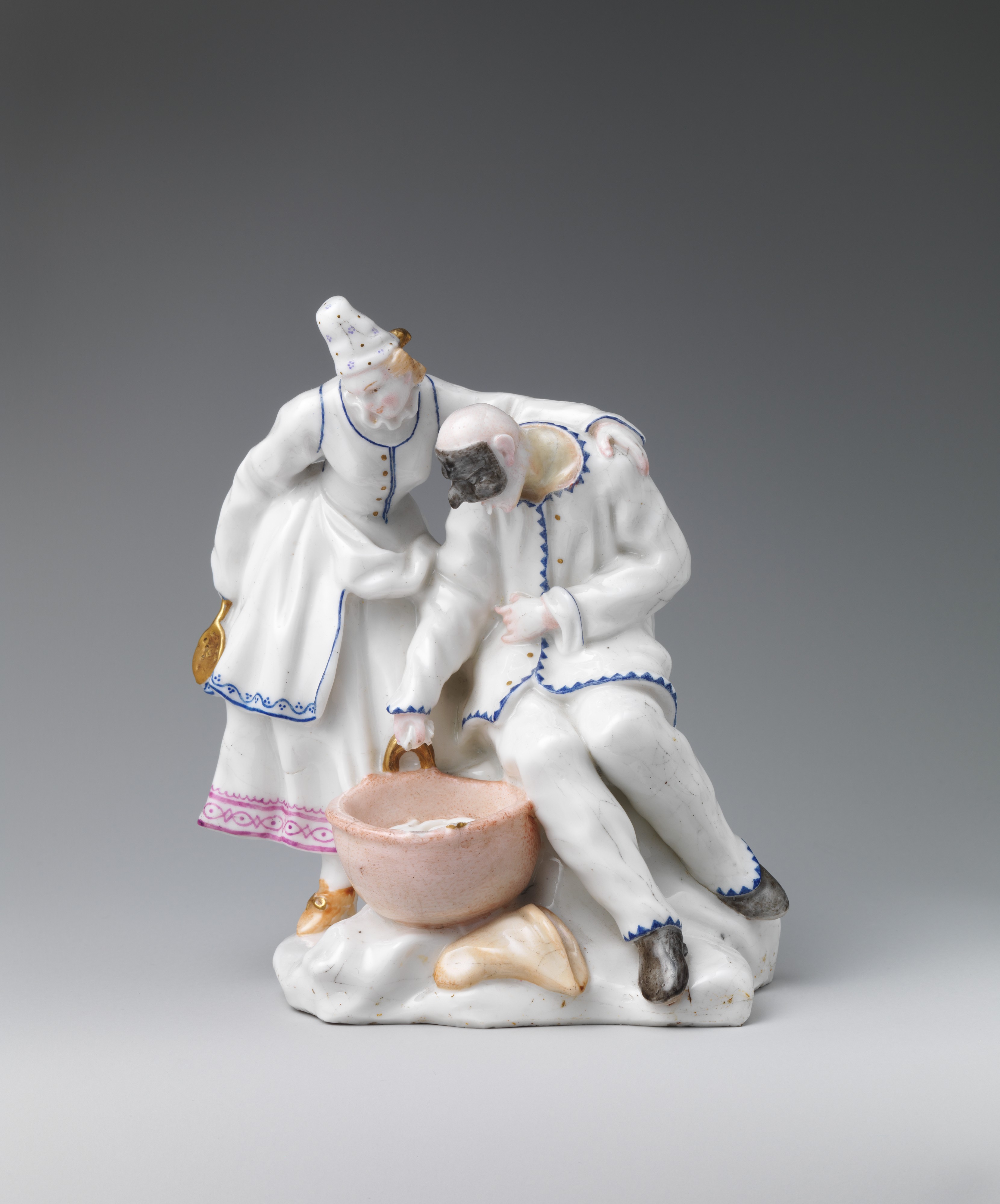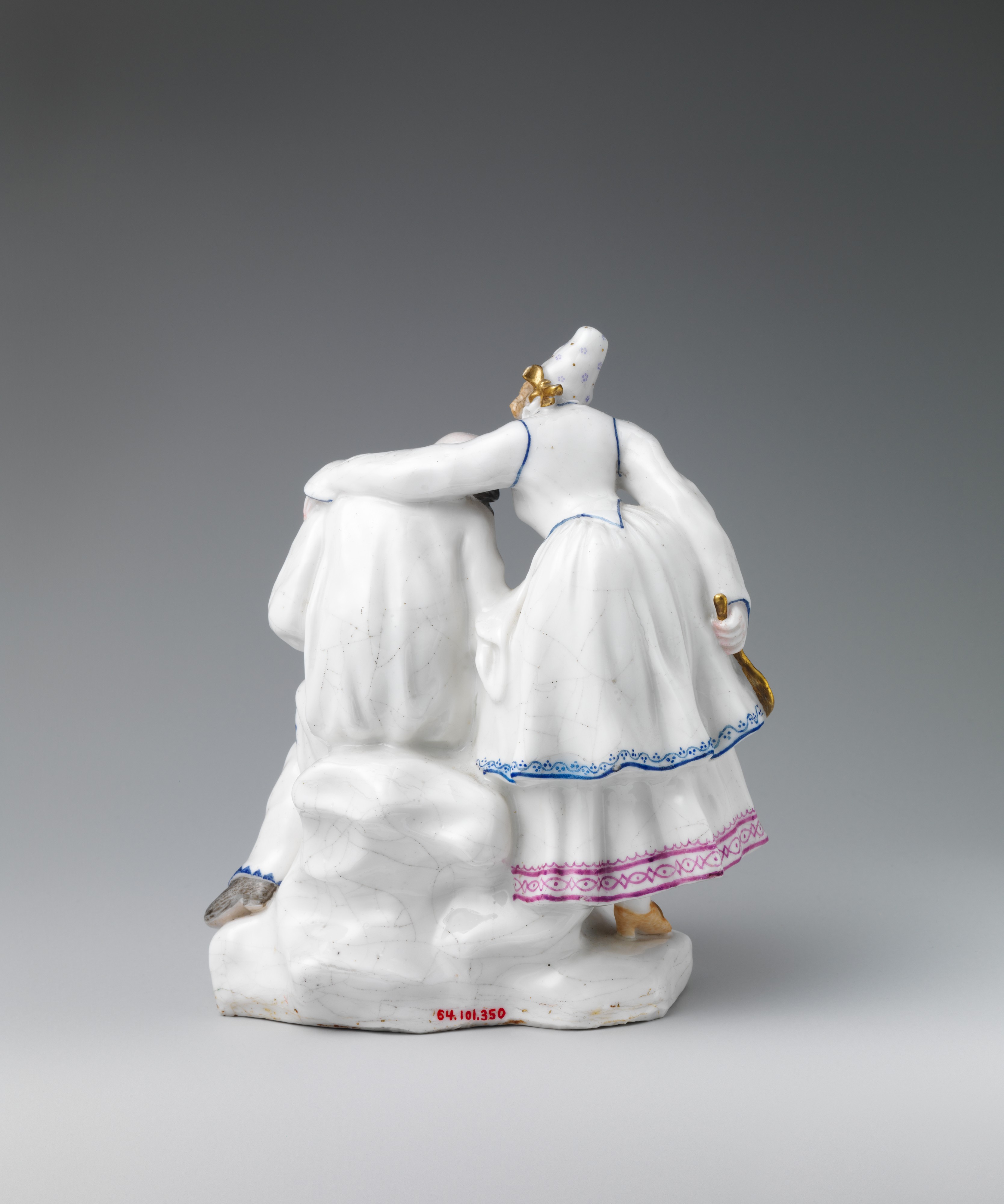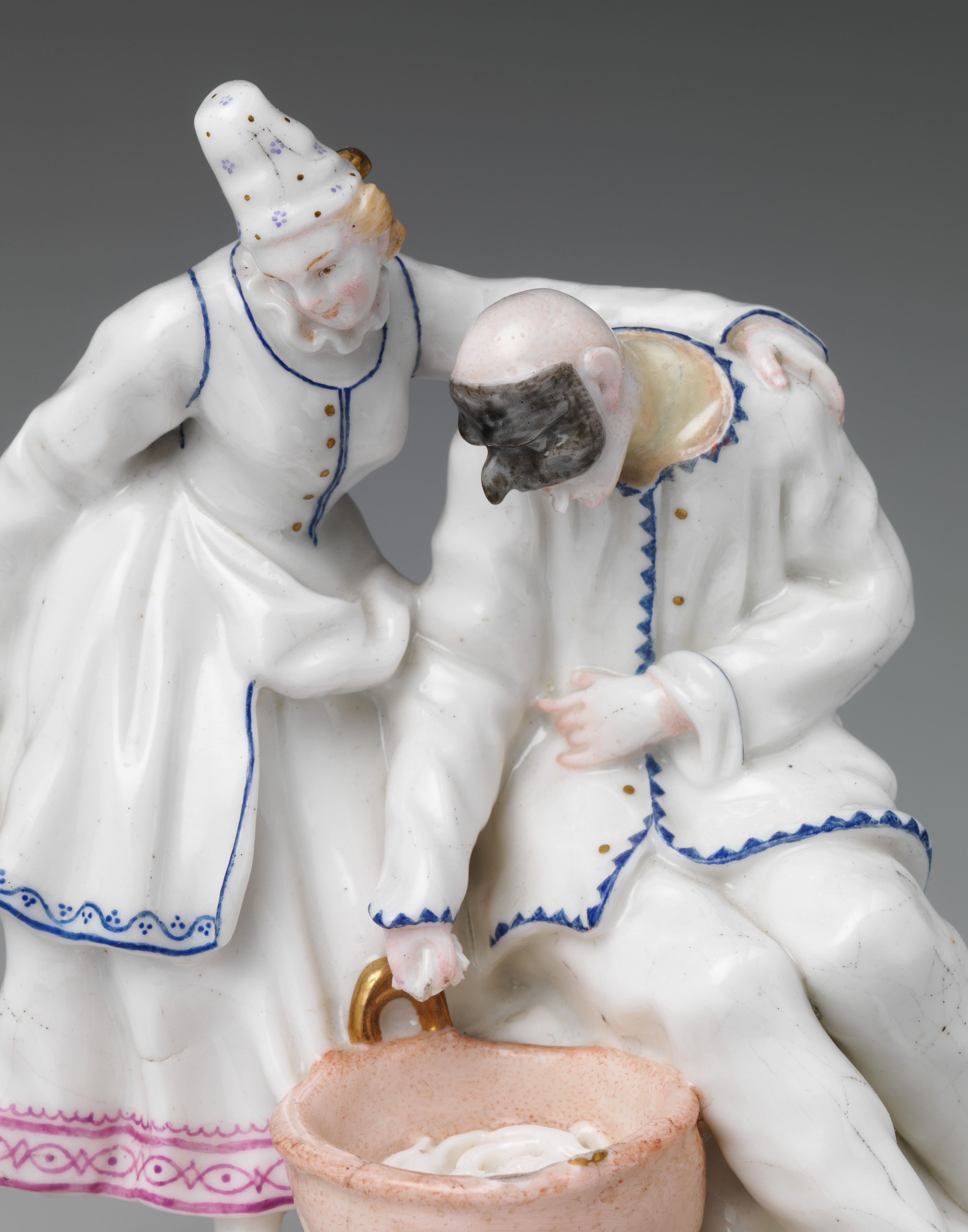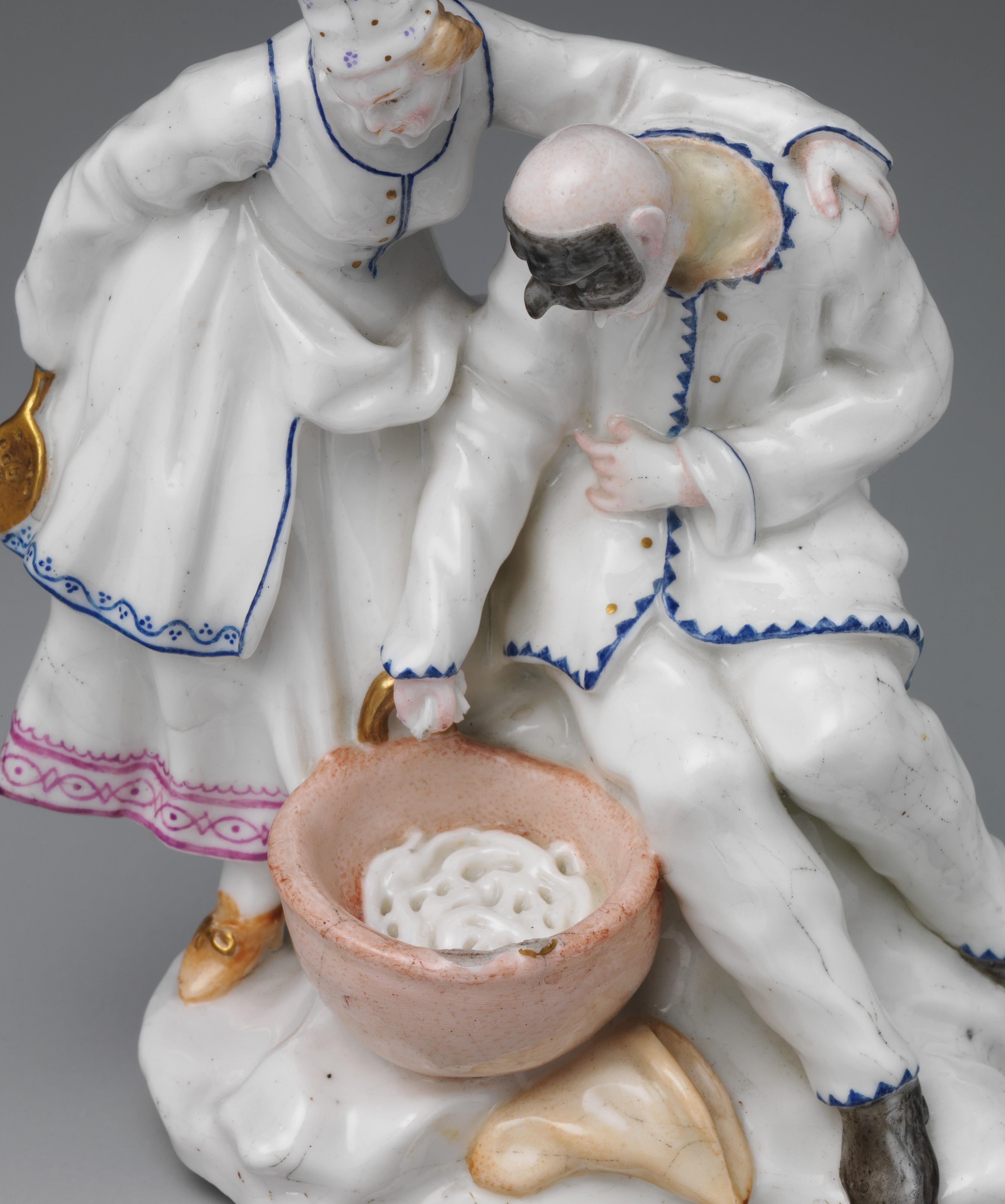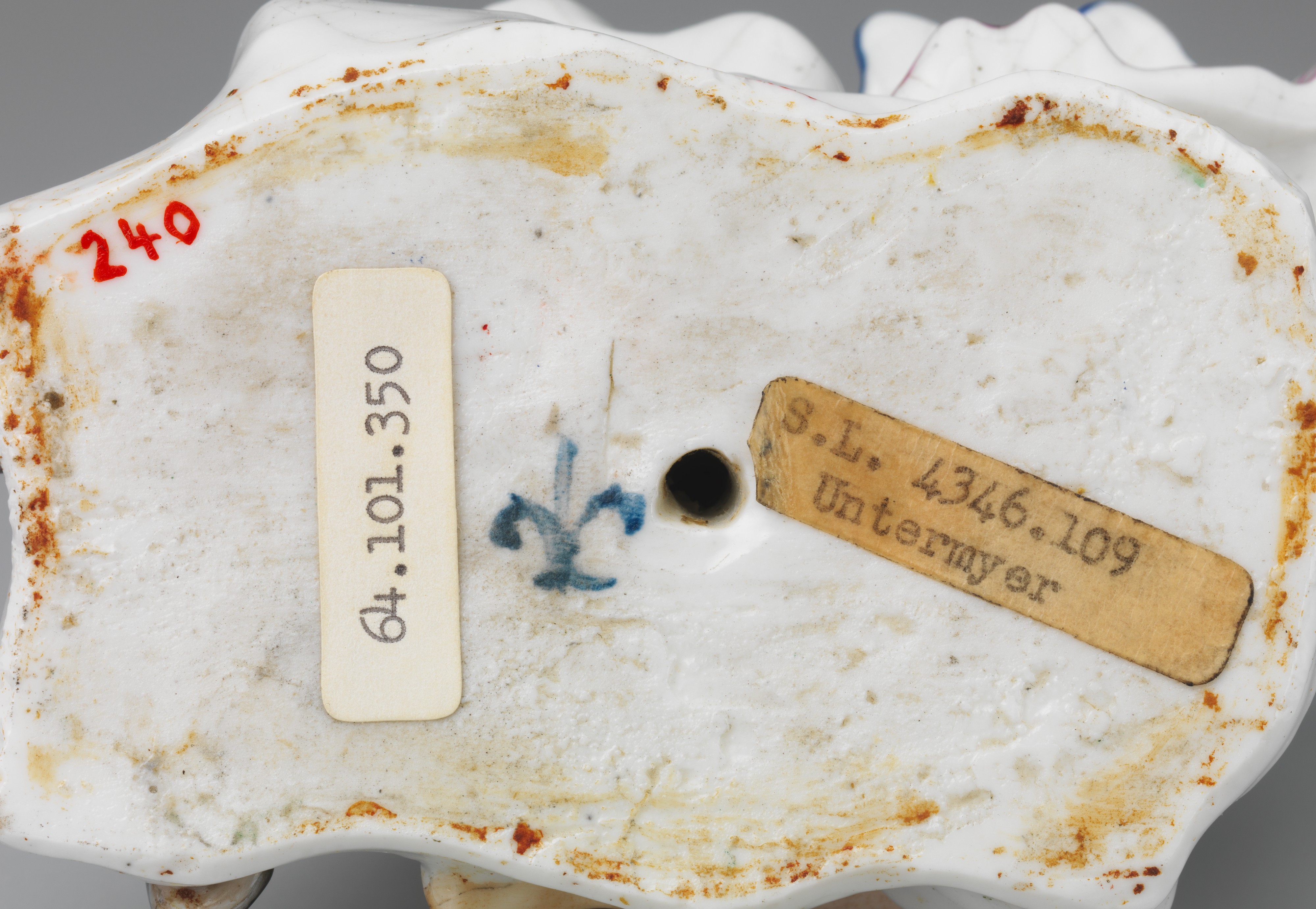The Spaghetti Eaters (Columbine and Pulcinella)
Manufactory Capodimonte Porcelain Manufactory Italian
Model attributed to Giuseppe Gricci Italian
Not on view
Giuseppe Gricci (Italian, ca. 1700–1770) was one of the most accomplished and prolific porcelain modelers of the eighteenth century and often compared to his contemporaries Johann Joachim Kandler (German, 1706–1775) at the Meissen porcelain factory in Germany (1982.60.300) and Franz Anton Bustelli (Swiss, d. 1763) at the Nymphenburg porcelain manufactory in Munich (1977.216.56) in terms of stature in the field of porcelain sculpture. Gricci’s work is remarkable for being executed in soft-paste porcelain, which did not permit the degree of detail or crispness that Kandler or Bustelli could achieve in working with the hard-paste porcelain. Very little is known about Gricci’s career before he joined the Capodimonte factory; nonetheless, his name appears in the factory’s first personnel list dated November 1743.[1] Gricci arrived in Naples from Florence, where he presumably received his training, and some of his earliest work at Capodimonte reflects an influence of Florentine Baroque sculpture.[2] It is clear that Gricci was a skilled sculptor by the time of his employment, and he was soon appointed head modeler.
Gricci’s talents as a sculptor in the medium of porcelain were made apparent when a group of large religious figures (1971.92.1, .2) were among the first works produced at Capodimonte during the mid-1740s. Shortly after these works appeared Gricci changed his focus and began producing a series of smaller figures that depict a wide range of secular subjects, including those drawn from daily life or from the commedia dell’arte. Gricci appears to have been influenced by numerous sources, but the majority of these figures produced during the second half of the 1740s to the mid-1750s share a number of characteristics. While the figures often have small heads, stocky or thickset limbs, and are simply defined, they nevertheless convey an expressiveness and sense of immediacy that distinguish them from figures made at other porcelain factories. The technical limitations imposed by soft-paste porcelain constrained Gricci in terms of detailed modeling, yet he was able to employ pose and gesture to create a dramatic tension that transcends the seemingly naive modeling. Gricci’s figures depicting activities of daily life reflect the reality of the occupations, or the encounters in which they are engaged, rather than conveying a stylized or abstract representation. His groups involving two or more figures are distinguished by the sense of rapport that he creates between the figures, which display a degree of emotional engagement not often found in the technically more sophisticated work of his contemporaries at other factories.
The Pottery Seller (1982.450.4) is one of Gricci’s most ambitious works belonging to a category known in the eighteenth century as la voci di Napoli (the criers of Naples). These figures represented the street merchants who sold wares that they carried and advertised them by their “cries” from the street throughout the city. In this figure, a barefoot male sells a wide variety of pots, cups, and dishes from the large basket that he carries on his back and from the bowl he clasps to his chest. Gricci has derived his composition from an engraving executed by Simon Guillain (French, b. 1618) in 1646 after a drawing by Annibale Carracci (1560–1609) (see The British Museum, Prints and Drawings inv. no. 1942.0514.3.1), one of the most important Italian artists of the Baroque period. Gricci closely copied Carracci’s depiction of a pottery seller, who is called Pignattaro in the engraving.[3] As Hugo Morley-Fletcher has observed, Gricci’s talent as a sculptor is evident in his skillful translation of two-dimensional images into three dimensions and in his ability to compose a back view for objects when there was no image to follow.[4] In addition, Gricci has animated the figure conceived by Carracci by raising the pottery seller’s head so that he engages with the viewer and by giving him a more energetic stance, which creates the impression that he is actively hawking his wares. While it appears that Gricci looked to a variety of sources for the figures that he created to represent la voci di Napoli, [5] the numerous vendors that he modeled are linked stylistically by their animated poses, the schematic but effective depiction of their wares, and by the sense of personality that Gricci effectively conveys.[6]
Gricci’s keen observation of human behavior and emotion also informs the figures that he modeled depicting characters from the commedia dell’arte. Gricci created a sizable number of figures drawn from the Italian comedy at the same time he was producing his voci di Napoli series, but it is likely that these theatrical figures were not made as part of a series but rather as independent works.[7] Similar to the street criers, Gricci looked to a variety of sources for inspiration, and it has (64.101.350).[8] In this group, Pulcinella sits gazing at a cauldron of spaghetti, while a standing Columbina leans toward the cauldron with her arm resting around Pulcinella’s shoulders. Pulcinella, identifiable from his distinctive mask and conical hat that lies on the rocky base, grabs a handful of spaghetti to eat, although strands of spaghetti already in his mouth reflect his gluttonous nature. Columbina holds a pasta strainer in her right hand, and her tender embrace suggests encouragement to continue eating. Ferretti executed a number of paintings that depict Harlequin engaged in a variety of activities, and in at least two of them, the subject is Harlequin’s love of food.[9] However, none of Ferretti’s compositions have been copied by Gricci for this group, but it is plausible that Gricci was influenced by them or, more likely, by prints made after them, as Harlequin has been transformed into Pulcinella in this instance. Regardless of his source of inspiration, Gricci created a composition in which simple but nuanced pose and gesture communicate a sympathy between the two figures that is just as apparent from the back as it is from the front.
In both The Pottery Seller and The Spaghetti Eaters, polychrome decoration is used very sparingly and employed primarily to define the rims of the pots and plates or the edges of the garments. Gricci’s figures produced from the mid-1740s through the early 1750s often have minimally painted decoration, which suggests that Gricci must have worked in concert with Giovanni Caselli (Italian, 1698–1752), director of the factory, to create this unusual balance between the white porcelain and its enamel decoration. Although the factory decorated some of its figures from this time period in a more conventional and fuller manner, the harmony between the undecorated and decorated porcelain is one of the distinguishing features of these early Capodimonte figures.[10]
Footnotes
(For key to shortened references see bibliography in Munger, European Porcelain in the Metropolitan Museum of Art. NY: The Metropolitan Museum of Art, 2018)
1 Martini 1981.
2 Carola-Perrotti 2010, p. 90. For example, Gricci’s Pieta group in the Museo Duca di Martina, Naples (Silvana Musella Guida in Porcellane di Capodimonte 1993, pp. 154–56, no. 86), recalls the work of Massimiliano Soldani Benzi (Italian, 1656–1740).
3 Angela Carola-Perrotti in Carola-Perrotti 1986b, p. 190, no. 125, ill.
4 Morley-Fletcher 1993, vol. 2, p. 32.
5 Carola-Perrotti 1993.
6 For other voci di Napoli figures, see Carola-Perrotti 1986b, pp. 190–95, nos. 125–31 (catalogue entries by Carola-Perrotti and Musella Guida); Diletta Clery in Ritorno al Barocco 2009, vol. 2, pp. 200–201, no. 4.90.
7 Carola-Perrotti 2001, pp. 67–68.
8 Chilton 2002, p. 224.
9 Baldassari 2002, p. 121.
10 Le Corbeiller 1985, p. 26. Clare Le Corbeiller’s brief discussion of the qualities of Capodimonte figural decoration is so eloquent that this author has simply paraphrased her perceptive observations.
Due to rights restrictions, this image cannot be enlarged, viewed at full screen, or downloaded.
This artwork is meant to be viewed from right to left. Scroll left to view more.


